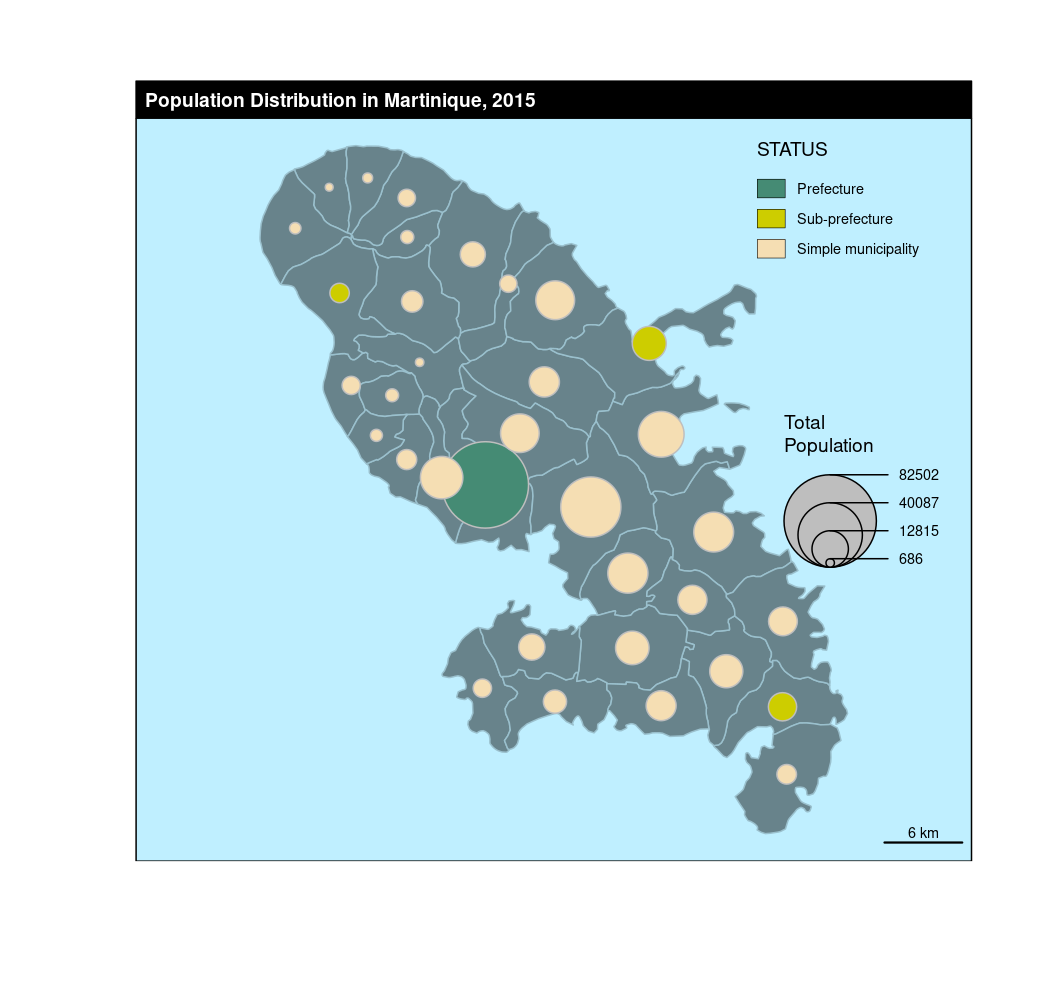Plot a proportional symbols layer with colors based on qualitative data.
propSymbolsTypoLayer(
x,
spdf,
df,
spdfid = NULL,
dfid = NULL,
var,
inches = 0.3,
fixmax = NULL,
symbols = "circle",
border = "grey20",
lwd = 1,
var2,
col = NULL,
colNA = "white",
legend.title.cex = 0.8,
legend.values.cex = 0.6,
legend.var.pos = "bottomleft",
legend.var.title.txt = var,
legend.values.rnd = 0,
legend.var.style = "c",
legend.var.frame = FALSE,
legend.var2.pos = "topright",
legend.var2.title.txt = var2,
legend.var2.values.order = NULL,
legend.var2.nodata = "no data",
legend.var2.frame = FALSE,
add = TRUE
)Arguments
- x
an sf object, a simple feature collection. If x is used then spdf, df, spdfid and dfid are not.
- spdf
SpatialPointsDataFrame or SpatialPolygonsDataFrame; if spdf is a SpatialPolygonsDataFrame symbols are plotted on centroids.
- df
a data frame that contains the values to plot. If df is missing spdf@data is used instead.
- spdfid
name of the identifier variable in spdf, default to the first column of the spdf data frame. (optional)
- dfid
name of the identifier variable in df, default to the first column of df. (optional)
- var
name of the numeric variable used to plot the symbols sizes.
- inches
size of the biggest symbol (radius for circles, width for squares, height for bars) in inches.
- fixmax
value of the biggest symbol. (optional)
- symbols
type of symbols, one of "circle", "square" or "bar".
- border
color of symbols borders.
- lwd
width of symbols borders.
- var2
name of the factor (or character) variable used to plot the symbols colors.
- col
a vector of colors.
- colNA
no data color.
- legend.title.cex
size of the legend title.
- legend.values.cex
size of the values in the legend.
- legend.var.pos
position of the legend, one of "topleft", "top", "topright", "right", "bottomright", "bottom", "bottomleft", "left" or a vector of two coordinates in map units (c(x, y)).
- legend.var.title.txt
title of the legend (numeric data).
- legend.values.rnd
number of decimal places of the values in the legend.
- legend.var.style
either "c" or "e". The legend has two display styles, "c" stands for compact and "e" for extended.
- legend.var.frame
whether to add a frame to the legend (TRUE) or not (FALSE).
- legend.var2.pos
position of the legend, one of "topleft", "top", "topright", "right", "bottomright", "bottom", "bottomleft", "left" or a vector of two coordinates in map units (c(x, y)).
- legend.var2.title.txt
title of the legend (factor data).
- legend.var2.values.order
values order in the legend, a character vector that matches var modalities. Colors will be affected following this order.
- legend.var2.nodata
text for "no data" values
- legend.var2.frame
whether to add a frame to the legend (TRUE) or not (FALSE).
- add
whether to add the layer to an existing plot (TRUE) or not (FALSE).
See also
Examples
library(sf)
mtq <- st_read(system.file("gpkg/mtq.gpkg", package="cartography"))
#> Reading layer `mtq' from data source
#> `/tmp/RtmpmpfIrO/temp_libpath18ee15f22a9e/cartography/gpkg/mtq.gpkg'
#> using driver `GPKG'
#> Simple feature collection with 34 features and 7 fields
#> Geometry type: MULTIPOLYGON
#> Dimension: XY
#> Bounding box: xmin: 690574 ymin: 1592536 xmax: 735940.2 ymax: 1645660
#> Projected CRS: WGS 84 / UTM zone 20N
# Countries plot
plot(st_geometry(mtq), col = "lightblue4",border = "lightblue3",
bg = "lightblue1")
# Population plot on proportional symbols
propSymbolsTypoLayer(x = mtq, var = "POP", var2 = "STATUS",
symbols = "circle",
col = c("aquamarine4", "yellow3","wheat"),
legend.var2.values.order = c("Prefecture",
"Sub-prefecture",
"Simple municipality"),
legend.var.pos = "right", border = "grey",
legend.var.title.txt = "Total\nPopulation")
layoutLayer(title = "Population Distribution in Martinique, 2015")
